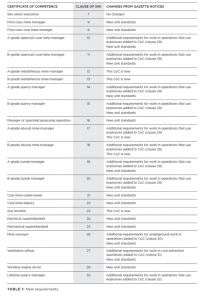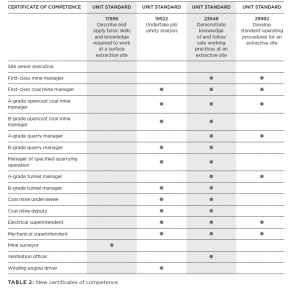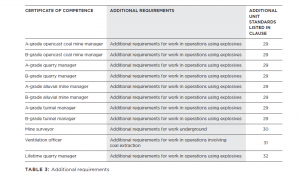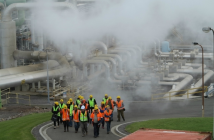WorkSafe is consulting on a proposed safe work instrument which outlines requirements for certificates of competence in the extractives industry

The proposed Health and Safety at Work (Mining Operations and Quarrying Operations – Prescribed Competency Requirements for Certificates of Competence) Safe Work Instrument 2023 will replace the gazette notices which have previously set the WorkSafe prescribed competency requirements for the extractives industry. These requirements are used by the Mining Board of Examiners for issuing certificates of competence.
The proposed safe work instrument ‘lifts and shifts’ the existing requirements from the gazette notices to the safe work instrument and incorporates new requirements under the amended regulations.
Safe work instruments
A SWI is a form of legislation that supplements regulations. SWIs allow for greater flexibility and more timely updates to the regulatory framework, reflecting changes in technology, standards, and health and safety practices.
The WorkSafe New Zealand Act 2013 gives WorkSafe the function of developing SWIs. Section 227 of the Health and Safety at Work Act 2015 (HSWA) allows SWIs to define terms, prescribe matters, or make other provision in relation to any activity or thing, including (without limitation) listing standards, control of substances, and competency requirements. SWIs have legal effect only if they are referred to in regulations.
A SWI must be approved by the Minister for Workplace Relations and Safety. To approve a SWI, the Minister must be satisfied that the appropriate persons and organisations have been consulted.
There is more information about SWIs on our website Safe work instruments
Why this SWI is needed
The Health and Safety at Work (Mining Operations and Quarrying Operations) Amendment Regulations 2022 (the Regulations) replace references to requirements set by a notice in the New Zealand Gazette with a reference to requirements in a SWI under Health and Safety at Work Act 2015 (HSWA). Setting requirements in a SWI will improve the accessibility of CoC requirements because the requirements
will be published on the WorkSafe website. It will also mean that future updates to the requirements can be made by amending the SWI, rather than issuing a new Gazette notice. This will make it easier for CoC holders and applicants to keep up to date with the most recent version of the requirements that apply for each CoC.
What does this SWI do?
It maintains most of the CoC requirements from the Gazette notice
The proposed CoC sets requirements for 22 CoCs. Most CoC requirements in this SWI have been ‘lifted and shifted’ from the previous Gazette notices. This means most requirements in the SWI are the same as the current requirements.
The wording of the requirements may be slightly different because as secondary legislation, SWIs must follow specific drafting rules. There have been minor changes to the wording of some requirements for clarity.
It establishes five new CoCs
The SWI creates five new CoCs which were not in previous Gazette notices:
– A-grade alluvial mine manager
– B-grade alluvial mine manager
– A-grade metalliferous mine manager
– B-grade metalliferous mine manager
– gas monitor.
It sets additional requirements for some CoC holders in certain operations
We are proposing additional requirements for work in operations using explosives, for work underground, or operations involving coal extraction. There is moreinformation on additional requirements and the CoCs they apply to below.
It changes the requirements in some SWIs
Some existing CoCs have new or different requirements:

It introduces new unit standards
The SWI introduces new unit standards for almost all previously existing CoCs. The CoCs with new unit standards are shown in the table below. Other than these changes, the unit standards required for each CoC are the same as those that were required by the Gazette notices:
- Download Feedback form
- Download Proposed mining and quarrying certificates of competence safe work instrument
- Download Consultation background document: Mining and quarrying certificates of competence safe work instrument

Additional requirements
Once the SWI is in effect, if a person intending to work in operations using explosives, underground, or in operations involving coal extraction applies for a new CoC or renews an existing CoC, they must have met any additional requirements applying to work in that type of operation. Gazette notices did not previously set additional requirements. Additional requirements are a necessary addition to certain CoCs to ensure the competence of CoC holders who carry out higher risk types of work.
Some CoCs allow holders to carry out work using explosives, underground or in operations involving coal extraction without meeting additional requirements. Those CoCs already require training and experience relevant to those types of work.
We have added additional requirements to those CoCs for which competence in a type of high-risk work is not necessary for the base CoC, but essential if the holder uses the base CoC to carry out specific high-risk work. Additional competency requirements for specified mining, quarrying and alluvial mining operations Additional requirements generally involve completing additional unit standards, except in the case of the additional requirements for a ventilation officer who intends to work in a coal extraction operation, which requires the applicant to have 12 months’ experience in an underground coal mine.
The table below details which CoCs have additional requirements and which clause in the SWI lists the additional unit standards:

Competency requirements for certificates of competence
The SWI sets out competency requirements for each type of CoC, including experience requirements. A summary of the requirements is set out below.
Unless indicated, these requirements are the same as those that applied under the previous Gazette notices:
– every CoC requires the applicant to pass a list of unit standards outlined in a separate schedule for each CoC
– every CoC, besides the site senior executive CoC, requires a first aid certificate – every CoC requires an examination before a panel of examiners, which will consider whether:
– the applicant has necessary knowledge and application of good mining practice in the subject areas covered by the particular CoC
– the applicant can communicate effectively to individuals or groups about relevant health and safety issues at an extractive site
– the experience requirements state that certain experience must be ‘acceptable to the Board’. The Mining Board of Examiners (the Board) may query the nature of the experience to determine whether it meets the requirements.
– previously the Gazette notice required experience in ‘more than one’ (in other words, two or more) types of work. Now, the SWI requires three or more types of work. This is to ensure that applicants’ experience is more varied and reflects the types of work CoC holders will do – all reference to ‘shift work’ has been changed to ‘back-bye work’. In the Gazette notices these terms were used interchangeably. For clarity, the SWI now only uses ‘back-bye work’
– the SWI does not refer to CoCs granted under former regulations. This is because the Board does not retain information from former regulations, and because new applicants should be able to apply for a CoC based on the strength of their current experience Holders of any of the following manager CoCs can have their CoC considered when they apply for another manager CoC listed below, and will not have to
meet the usual work experience requirements for that CoC (see clauses 10, 11, 14, 15, 17, 18 of the SWI):
– A-grade opencast coal mine manager
– B-grade opencast coal mine manager
– A-grade alluvial mine manager
– B-grade alluvial mine manager
– A-grade quarry mine manager
– B-grade quarry mine manager.
New CoCs
A-grade metalliferous mine manager
Managers of metalliferous mines previously required a tunnel manager CoC. A- and B-grade metalliferous mine manager CoCs are being introduced to reflect recent changes to the Regulations that differentiate the experience and knowledge required in tunnel management and metalliferous mine management.
B-grade metalliferous mine manager
Management of metalliferous mines previously required a tunnel manager CoC.
A- and B-grade metalliferous mine manager CoCs are being introduced to reflect recent changes to the Regulations that differentiate the experience and knowledge required in tunnel management and metalliferous mine management.
A-grade alluvial mine manager
Management of alluvial mines previously required a quarry manager CoC.
A- and B-grade alluvial mine manager CoCs are being introduced to reflect recent changes to the Regulations that were made to acknowledge that the management of many alluvial mining operations does not require the same level of knowledge and experience as quarry operations.
B-grade alluvial mine manager
Management of alluvial mines previously required a quarry manager CoC.
A- and B-grade alluvial mine manager CoCs are being introduced to reflect recent changes to the Regulations that were made to acknowledge that the management of many alluvial mining operations do not require the same level of knowledge and experience as quarry operations.
Gas monitor
The gas monitor CoC introduces a CoC for a more specialised safety critical role focused on monitoring flammable gases in active surface coal exploration sites.
The new CoC indicates competence in monitoring gas, allowing any person with this CoC to carry out this work. Previously a site senior executive would need to be present when gas monitoring took place.
CoCs with significant changes
Ventilation officer
A change to the ventilation officer CoC from the Gazette notice relates to the new additional requirements for coal extraction. In addition to the extra unit standards that are needed to meet additional requirements, any applicant who intends to use their ventilation officer CoC in a coal mine will need at least 12 months’ experience in the workings of an underground coal mine. This is to
ensure that the applicant has an in-depth understanding of the workings and risks of an underground coal mine.
Continuing professional development (CPD) requirements
CPD requirements have mostly been lifted and shifted unchanged into the SWI from the Gazette notices. The main change is additional competency requirements for lifetime quarry managers.
Additional competency requirements for holders of lifetime
quarry manager CoCs
CPD requirements for lifetime quarry managers were previously set in the Health and Safety at Work (Mining Operations and Quarrying Operations) Regulations 2016 rather than in Gazette notices. Lifetime quarry manager CoC holders must now meet the additional competency requirements in this SWI, as there are no longer requirements for CoC holders in the Regulations.
A lifetime quarry manager CoC holder must complete the CPD hours that their equivalent quarry manager CoC would have to complete, within a five-year period. The equivalent quarry manager CoC will either be A-grade or B-grade, depending on the lifetime quarry manager CoC that was issued.
The first five-year period for CPD for lifetime quarry managers commenced on 1 January 2023. A person who holds a lifetime quarry manager CoC must comply with the CPD requirements, regardless of whether they have worked in the industry during any five-year period.
2024 Amendment SWI – new unit standards
Several unit standards will be added into certain CoC requirements by an amendment to the SWI in 2024 and will not be required for CoCs issued before the amendments.
You will have the opportunity to provide feedback on the new unit standards when we consult on the amendments in 2024.







